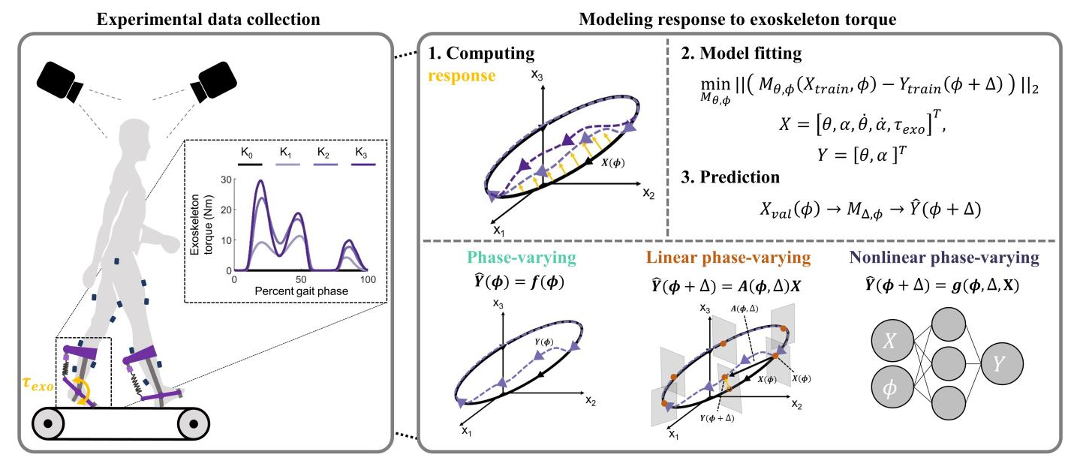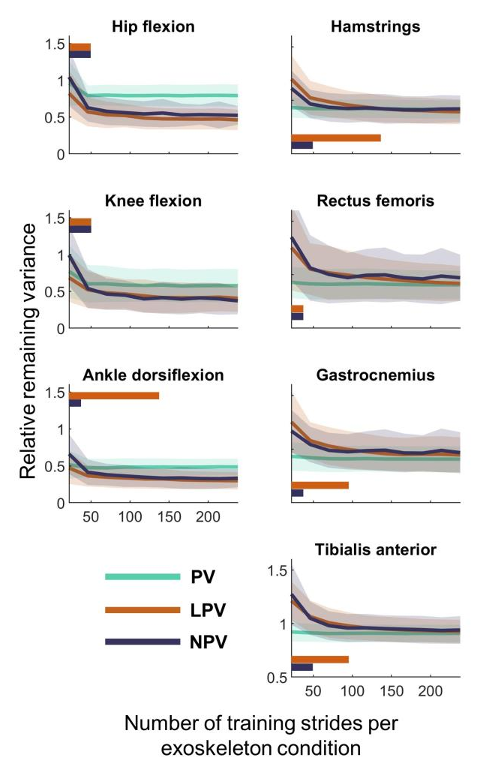
1
Predicting walking response to ankle
1
exoskeletons using data-driven models
2
Michael C. Rosenberg
1
, Bora S. Banjanin
2
, Samuel A. Burden
2
, Katherine M. Steele
1
3
1
Department of Mechanical Engineering, University of Washington, Seattle, WA, USA
4
2
Department of Electrical and Computer Engineering, University of Washington, Seattle, WA, USA
5
Correspondence: mcrosenb@uw.edu
6
7
I. KEYWORDS
8
Ankle exoskeleton; data-driven modeling; locomotion; prediction; joint kinematics; muscle activity
9
10
II. ABSTRACT
11
Despite recent innovations in exoskeleton design and control, predicting subject-specific impacts of
12
exoskeletons on gait remains challenging. We evaluated the ability of three classes of subject-specific phase-
13
varying models to predict kinematic and myoelectric responses to ankle exoskeletons during walking, without
14
requiring prior knowledge of specific user characteristics. Each model – phase-varying (PV), linear phase-
15
varying (LPV), and nonlinear phase-varying (NPV) – leveraged Floquet Theory to predict deviations from a
16
nominal gait cycle due to exoskeleton torque, though the models differed in complexity and expected
17
prediction accuracy. For twelve unimpaired adults walking with bilateral passive ankle exoskeletons, we
18
predicted kinematics and muscle activity in response to three exoskeleton torque conditions. The LPV
19
model’s predictions were more accurate than the PV model when predicting less than 12.5% of a stride in
20
the future and explained 49–70% of the variance in hip, knee, and ankle kinematic responses to torque. The
21
LPV model also predicted kinematic responses with similar accuracy to the more-complex NPV model.
22
Myoelectric responses were challenging to predict with all models, explaining at most 10% of the variance
23
in responses. This work highlights the potential of data-driven phase-varying models to predict complex
24
subject-specific responses to ankle exoskeletons and inform device design and control.
25
(which was not certified by peer review) is the author/funder. All rights reserved. No reuse allowed without permission.
The copyright holder for this preprintthis version posted September 21, 2020. ; https://doi.org/10.1101/2020.06.18.105163doi: bioRxiv preprint

2
III. INTRODUCTION
26
Ankle exoskeletons are used to improve kinematics and reduce the energetic demands of locomotion in
27
unimpaired adults and individuals with neurologic injuries [1-5]. Customizing exoskeleton properties to
28
improve an individual’s gait is challenging and accelerating the iterative experimental process of device
29
optimization is an active area of research [6, 7]. Studies examining the effects of exoskeleton properties –
30
sagittal-plane ankle stiffness or equilibrium ankle angle for passive exoskeletons and torque control laws for
31
powered exoskeletons – on kinematics, motor control, and energetics have developed design and control
32
principles to reduce the energetic demand of walking and improve the quality of gait [1, 6, 8, 9]. Predicting
33
how an individual’s gait pattern responds to ankle exoskeletons across stance may inform exoskeleton design
34
by enabling rapid evaluation of exoskeleton properties not tested experimentally. Additionally for powered
35
exoskeletons, which prescribe torque profiles using feedforward or feedback (e.g. kinematic or myoelectric)
36
control laws, predicting responses over even 10–20% of a stride may improve tracking performance or
37
transitions between control modes [4, 10-12]. However, predicting subject-specific responses to exoskeletons
38
remains challenging for unimpaired individuals and those with motor impairments [2, 12, 13].
39
40
Common physics-based models, including simple mechanical models and more physiologically-detailed
41
musculoskeletal models, use principles from physics and biology to analyze and predict exoskeleton impacts
42
on gait. For example, one lower-limb mechanical walking model predicted that an intermediate stiffness in a
43
passive exoskeleton would minimize the energy required to walk, a finding that was later observed
44
experimentally in unimpaired adults [1, 14]. More physiologically-detailed musculoskeletal models have
45
been used to predict the impacts of exoskeleton design on muscle activity during walking in children with
46
cerebral palsy and running in unimpaired adults [15, 16]. While these studies identified hypothetical
47
relationships between kinematics and the myoelectric impacts of exoskeleton design parameters, their
48
predictions were not evaluated against experimental data.
49
50
(which was not certified by peer review) is the author/funder. All rights reserved. No reuse allowed without permission.
The copyright holder for this preprintthis version posted September 21, 2020. ; https://doi.org/10.1101/2020.06.18.105163doi: bioRxiv preprint

3
Challenges to accurately predicting responses to ankle exoskeletons with physics-based models largely stem
51
from uncertainty in adaptation, musculoskeletal physiology, and motor control, which vary between
52
individuals and influence response to exoskeletons. While individuals explore different gait patterns to
53
identify an energetically-optimal gait, exploration does not always occur spontaneously, resulting in sub-
54
optimal gait patterns for some users [17]. Popular physiologically-detailed models of human gait typically
55
assume instantaneous and optimal adaptation, which do not reflect how experience and exploration may
56
influence responses to exoskeletons, possibly reducing the accuracy of predicted responses [18, 19].
57
Additionally, when specific measurement sets are unavailable for model parameter tuning, population-
58
average based assumptions about musculoskeletal properties and motor control are required [17, 20-22].
59
However, musculoskeletal properties and motor control are highly uncertain for individuals with motor
60
impairments, today’s most ubiquitous ankle exoskeleton users [19, 20, 22, 23]. Musculotendon dynamics and
61
motor complexity are known to explain unintuitive exoskeleton impacts on gait energetics, suggesting that
62
uncertain musculotendon parameters and motor control may limit the accuracy of predicted changes in gait
63
with ankle exoskeletons [19, 21, 24]. Predictions of exoskeleton impacts on gait using physiological models,
64
therefore, require accurate estimates of adaptation, musculotendon parameters, and motor control.
65
66
Conversely, data-driven approaches address uncertainty in user-exoskeleton dynamics by representing the
67
system entirely from experimental data. For instance, human-in-the-loop optimization provides a model-free
68
alternative to physics-based prediction of exoskeleton responses by automatically exploring different
69
exoskeleton torque control strategies for an individual [6, 7]. This experimental approach requires no prior
70
knowledge about the individual: optimization frameworks identify torque control laws that decrease
71
metabolic rate relative to baseline for an individual using only respiratory data and exoskeleton torque
72
measurements. However, experimental approaches to exoskeleton optimization require the optimal design to
73
be tested, potentially making the search for optimal device parameters time-intensive. Alternatively, machine
74
learning algorithms, such as the Random Forest Algorithm, have used retrospective gait analysis and clinical
75
(which was not certified by peer review) is the author/funder. All rights reserved. No reuse allowed without permission.
The copyright holder for this preprintthis version posted September 21, 2020. ; https://doi.org/10.1101/2020.06.18.105163doi: bioRxiv preprint

4
exam data to predict changes in joint kinematics in response to different ankle-foot orthosis designs in
76
children with cerebral palsy [8]. This study reported good classification accuracy, though predictions may
77
not generalize to new orthosis designs. Unlike physiologically-detailed or physics-based models, human-in-
78
the-loop optimization and many machine learning models are challenging to interpret, limiting insight into
79
how a specific individual’s physiology influences response to exoskeleton torque. A balance between
80
physiologically-detailed and model-free or black-box data-driven approaches may facilitate the prediction
81
and analysis of responses to ankle exoskeletons without requiring extensive knowledge of an individual’s
82
physiology.
83
84
In this work, we investigated a subject-specific data-driven modeling framework – phase-varying models –
85
that may fill the gap between physiologically-detailed model-based and model-free experimental approaches
86
for predicting gait with exoskeletons. Phase-varying models typically have linear structure whose parameters
87
are estimated from data, enabling both prediction and analysis of gait with exoskeletons [25, 26]. Unlike
88
physiologically-detailed models, phase-varying models do not require knowledge of the physics or control
89
of the underlying system. Unlike experimental approaches, the model-based framework enables prediction
90
of responses to untested exoskeleton designs or control laws.
91
92
Phase-varying models leverage dynamical properties of stable gaits derived from Floquet Theory, which
93
ensures that the convergence of a perturbed trajectory to a stable limit cycle may be locally approximated
94
using time-varying linear maps [27]. Similar principles have been shown to generalize to limit cycles in non-
95
smooth or hybrid systems, such as human walking [28]. Moreover, phase-varying modeling principles have
96
been applied to biological systems, identifying linear phase-varying dynamics to investigate gait stability and
97
predict changes in kinematics in response to perturbations [25, 26, 29-31]. Responses to ankle exoskeleton
98
torques may be similarly defined as perturbations off an unperturbed (i.e. zero torque) gait cycle, suggesting
99
that the principles of phase-varying models will generalize to walking with exoskeletons. To the best of our
100
(which was not certified by peer review) is the author/funder. All rights reserved. No reuse allowed without permission.
The copyright holder for this preprintthis version posted September 21, 2020. ; https://doi.org/10.1101/2020.06.18.105163doi: bioRxiv preprint

5
knowledge, phase-varying models have never been used to study walking with exoskeletons and the extent
101
to which the principles underlying phase-varying models of locomotion generalize to walking with
102
exoskeletons is unknown.
103
104
To determine if phase-varying models represent useful predictive tools for locomotion with exoskeletons, the
105
purpose of this research was to evaluate the ability of subject-specific phase-varying models to predict
106
kinematic and myoelectric responses to ankle exoskeleton torque during walking. We predicted responses to
107
exoskeletons in unimpaired adults walking with passive ankle exoskeletons under multiple dorsiflexion
108
stiffness conditions. We focused on three related classes of phase-varying models with different structures,
109
complexity, and expected prediction accuracies: a phase-varying (PV), a linear phase-varying (LPV), and a
110
nonlinear phase-varying (NPV) model. Since passive exoskeletons typically elicit small changes in joint
111
kinematics and muscle activity, we expected the validity of Floquet Theory for human gait to extend to gait
112
with exoskeletons, indicating that the LPV model should accurately predict responses to passive exoskeleton
113
torque [1, 25-27, 29]. We, therefore, hypothesized that the LPV models would predict kinematic and
114
myoelectric responses to torque more accurately than the PV model and as accurately as the NPV model. To
115
exemplify the potential utility of subject-specific phase-varying models in gait analysis with ankle
116
exoskeletons, we show how varying the length of model prediction time horizon may inform measurement
117
selection for exoskeleton design and control. To assess the viability of data-driven phase-varying models in
118
gait analysis settings, we evaluated the effect of limiting the size of the training dataset on prediction
119
accuracy.
120
121
IV. METHODS
122
A. Experimental protocol
123
We collected kinematic and electromyographic (EMG) data from 12 unimpaired adults (6 female / 6 male;
124
age = 23.9 ± 1.8 years; height = 1.69 ± 0.10 m; mass = 66.5 ± 11.7 kg) during treadmill walking with bilateral
125
(which was not certified by peer review) is the author/funder. All rights reserved. No reuse allowed without permission.
The copyright holder for this preprintthis version posted September 21, 2020. ; https://doi.org/10.1101/2020.06.18.105163doi: bioRxiv preprint





